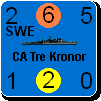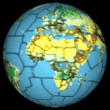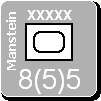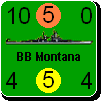Shannon V. OKeets
Posts: 22095
Joined: 5/19/2005
From: Honolulu, Hawaii
Status: offline

|
I forgot to list these two new writeups for the optional rules.
=============================================================
[43][Partisans][RAW 46 s. 13.1]
This optional rule adds partisan units to the game. Partisans played a major role in WW II, threatening supply lines and other weak points behind the front lines and requiring the major powers to deploy troops on garrison duty in conquered countries. However, by selecting this optional rule, players add quite a bit of complexity to the sequence of play.
Partisans are units that appear in conquered countries, and, in some cases, where fighting continues. There are a few countries that have partisans no matter who controls them; they fight against both the Axis and the Allies. Partisans can attack, block movement, and occupy hexes.
Here are some good things about having partisans on your side:
∙ they cost nothing to build or maintain,
∙ they are always in supply,
∙ enemy major powers can't use any resources or factories in a hex a partisan occupies,
∙ enemy factories and resources can't enter or pass through a hex a partisan occupies,
∙ enemy units can't enter a hex a partisan occupies, except by overrunning it,
∙ enemy major powers can't trace supply into or through a hex a partisan occupies,
∙ units of the partisan's nationality (only) can debark, or paradrop, into the hex the partisan occupies without having to fight a notional unit,
∙ enemy aircraft and naval units are overrun if a partisan is placed in or moves into a hex,
∙ stored oil, oil resources, and blue factories may be destroyed (if the corresponding optional rules are in effect).
Here are some bad things about having partisans on your side:
∙ their arrival is random - you may or may not have partisans show up,
∙ they are weak units with limited mobility,
∙ you only get partisans if a country you control has been invaded or conquered by the enemy,
∙ only some countries get partisans,
∙ there is a maximum to the number of partisans that can be active in a country,
∙ partisans have no ZOC outside of the hex they occupy,
∙ their presence in a hex does not change who controls the hex,
∙ no partisans appear if the garrison level for the country is high enough.
Partisans arrive during the first step of the End of Turn Stage in the sequence of play. This can be especially devastating since at the end of a turn many units are passive and most vulnerable to partisans. The process for which partisans arrive and how many is determined by the program rolling dice (i.e., randomly) and cross referencing the partisan table. Even then no partisans appear unless the randomly selected countries meet the necessary preconditions for partisans. The preconditions are: the country has either been conquered or at least 1 of its hexes contains an enemy unit.
The probability of partisans arriving increases if partisans are already present (per partisan present) and decreases if there are enemy units present (on garrison duty). To be counted as being on garrison duty, the unit must be: (1) active, (2) not in an enemy ZOC, and (3) on the opposite side from the side that will control the partisan. The garrison value of a unit depends on its size and type:
∙ ½ for divisions,
∙ 0 for carrier air units and all naval units,
∙ 2 for armor, mechanized, mountain, SS, and HQ-A units (corps/army size), and
∙ 1 for all other land and air units.
The program calculates the garrison values for each country and uses that information when deciding whether partisans will arrive. Note that, unlike neutrality pact garrison values, anti-partisan garrison values are never doubled, halved, or modified by entry markers.
Partisans in Manchuria, Korea, Indo-China, India, Burma, Malaya, and NEI are controlled by the nearest major power currently at war with the major power that controls the country. The nearest is the major power whose capital city is closest to the minor's capital city. If no major powers are at war with the controlling major power, then the nearest major power on the other side runs the partisans. [The above list of countries are those where the partisans were fighting for independence and fought any occupying army, both Axis and Allied.]
Partisans in most countries (all except Manchuria, Korea, Indo-China, India, Burma, Malaya, and NEI) are controlled by the major power that controlled their country before it was conquered (or still control it if it isn't yet conquered). Partisans in China are always communist Chinese units. French partisans are controlled by the Free French unless it is completely conquered, after which they are controlled by the Soviets. [This paragraph reflects the more common situation where the partisans fought against whoever invaded the country. They had the expectation that the side they supported would eventually liberate their country from the invader. Indeed, if a player chooses to not liberate a country that could be liberated, the country’s partisans fight against the new ‘conqueror’ (the same as Manchuria, Korea, et al) until it is liberated.]
Partisans are drawn randomly from the partisan force pool. There is a maximum of 3 partisan units per country, and since they are corps sized units, the maximum number of partisan units in a hex is 2. The composition of the partisan force pool changes year to year which changes the probability of drawing weak, weaker, or very weak partisan units. The strength of the units you have drawn previously has no effect on the probability of what you will draw next. In particular, there is a limitless pool of partisans to draw from - subject to the 3 unit maximum per country. [This section of the partisan rule is quite different from WIF FE because there is no longer any restriction due to the counter mix.]
The sequence in which partisans are placed on the map is determined by the partisan table and the program enforces the order in accordance with that table. The controlling major power can place a partisan unit in any enemy controlled hex in the partisan’s country that is not in an enemy ZOC. If there are no such hex, the partisan does not arrive.
After being placed on the map partisans may be moved like other land units during each impulse. They may move anywhere within their home country; but they can never leave their home country. Partisans only co-operate with other units from their own country. 1 is added to each partisan unit's combat factors if it is defending in a forest or jungle hex. Shattered partisans are destroyed instead of being shattered. Partisans are always at war with the conquering major power (and it's aligned minors) even if the partisan's controlling major power is not at war with the conqueror.
Partisans are not removed from the map neither when their country nor their controlling major power has been conquered. Even if their controlling major power has been completely conquered, partisans can still move and fight every turn as if their controlling major power had chosen a land action.
=============================================================
[44][Isolated Reorganization Limits][RAW 47 s. 13.5]
This optional rule denies reorganization to isolated units during the final reorganization step (part of the End of Turn Stage).
Units can be reorganized from passive to active during the final reorganization step of the End of Turn Stage, only if they can trace a basic supply path to a primary supply source for the unit. The path can include overseas supply paths and it can be of any length. Effectively, this denies the automatic reorganization to isolated units.
_____________________________
Steve
Perfection is an elusive goal.
|
 Printable Version
Printable Version













 .
.

 New Messages
New Messages No New Messages
No New Messages Hot Topic w/ New Messages
Hot Topic w/ New Messages Hot Topic w/o New Messages
Hot Topic w/o New Messages Locked w/ New Messages
Locked w/ New Messages Locked w/o New Messages
Locked w/o New Messages Post New Thread
Post New Thread